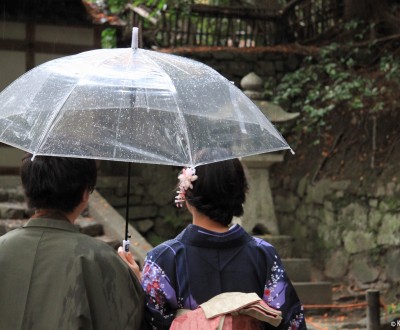Tsuyu: the Rainy Season in Japan
Tsuyu is the Japanese word to describe the rainy season in Japan. This period usually begins in mid-June and ends in mid-July, from south to north in the archipelago, except Hokkaido. The rainfalls may vary in intensity, with sometimes continuous precipitations that help moisten summer’s first warmth.
Seasons in Japan are generally very distinctive. The weather follows quite "rigorous" patterns and it is therefore possible to define clear periods more or less favorable to travel.
For example in Kanto area: sakura 🌸 cherry blossoms are blooming in the first week of April; momiji 🍁 are at their peak during the second half of November, and summer’s highest temperatures are expected summer between mid-July and late August, and so on.
In this calendar, another characteristic period should not be forgotten: tsuyu ☔️ (梅雨, literally "plum rain") that can be considered the rainy season.
☔️ Time periods and frequency of the rainfalls
Japan is not a monsoon country, but during these six weeks, rain certainly pours more than during the rest of the year. It is not necessarily raining every day, nor on a regular basis though. Several days can pass without any drop falling. However, most of the time, brief rains and downpours frequently occur, at any time during this period.
The rainfall season is such a prominent part of the Japanese daily life that two animated movies were based on it: The Garden of Words (2013), and Weathering with you (2019), both by Makoto Shinkai.
During the rainy season the atmosphere is characterized by dampness, and the humidity level raises considerably (about 70 to 75%) almost up to its summer level. It is also the favorite time of the year for cockroaches. During this period preceding the typhoon 🌀 season, winds blow stronger than in spring.
According to the Japan Meteorological Agency, tsuyu season (also known as baiyu) takes place between the following dates:
- Tokyo and surroundings: from June 8 to July 21,
- Kansai (Kyoto, Osaka, Nara...): from June 7 to July 21,
- Tohoku: from June 12 to July 28,
- Shikoku: from June 5 to July 18,
- Kyushu: from May 31 to July 19,
- Okinawa: from May 9 to June 23.
Note however that these dates are the previsions for maximum length and that tsuyu rarely lasts this long. On the contrary, over the last years (except in 2020), the rainy season tended to be shorter, and sometimes unnoticeable due to climate changes. In 2021 and 2023, the rainy season started about twenty days earlier than usual.
Hokkaido and Ogasawara archipelago are the only areas that tsuyu does not affect.
A second rainy season, significantly less intense, also exists in Japan between mid-September and early October: it's called Akisame 秋雨, ie the "autumn rain."
🌂 Traveling during the Japanese rainy season
Rainy seasons are not necessarily the most profitable to travel to Japan, but if this is your only available period, it's still possible to enjoy your stay. Just make sure to avoid planning only outdoor visits!
Then, make good use of umbrellas, quite a Japanese institution! Lastly, plan indoor visits (museums, shopping arcades and department stores, onsen ♨️...) and visit regions that revel in moisture, such as Mount Koya or Yakushima to fully embrace tsuyu.
Moreover, many stores have an array of waterproof (防水 bôsui in Japanese) clothes and accessories available throughout the season. You can naturally shop at the unavoidable Uniqlo retail stores, but even in the ¥100 Shops, it is possible to find raincoats at the lowest cost.
On the bright side, in June, the prices of flights ✈️ tickets are often less expensive than during the rest of the year. All the more as this season is not overlapping with school holidays. If your budget is tight you may consider traveling during this period!
Either way, never mind the rain and have a good trip!


